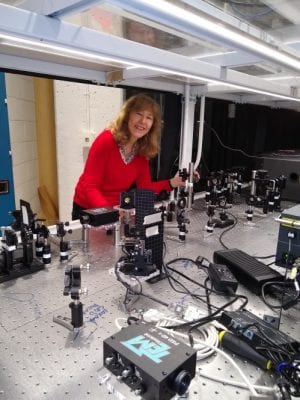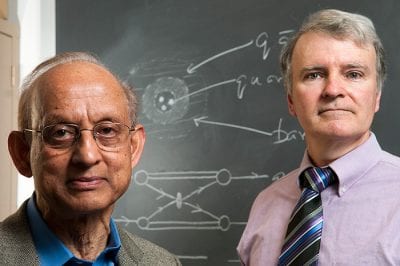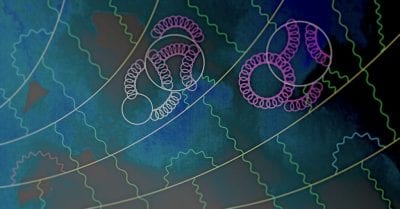New Physics PhD graduate Yasaman Homayouni is featured in a story on the class of 2021 from the College of Liberal Arts and Sciences (CLAS). For the full story of what inspired Yasaman and other students during their time at UConn, see the article in UConn Today.
Month: April 2021
An anomalous moment for the muon
Mark Rayner/CERN
The Fermilab E989 experiment announced the first new result on the muon’s anomalous magnetic moment in almost 20 years. The new measurement, combined with Brookhaven’s E821, has increased the discrepancy with the Standard Model value to 4.2 standard deviations. UConn Professors Tom Blum and Luchang Jin explain the theory calculations in a feature story in the Cern Courier.
Professor Nora Berrah Awarded a Blaise Pascal Chaire d’Excellence to Conduct Research in France
Professor of Physics Nora Berrah has been awarded the International Blaise Pascal Chaire d’Excellence, a prestigious honor whose previous winners include scientists and scholars from a wide range of disciplines, including multiple Nobel laureates. Her award was selected by a committee of scientists and voted on by the Permanent Commission Regional Council of the Région Île-de-France.

This award is bestowed to scientists of international reputation who are invited to conduct research in the Paris area. The goal is to establish international collaborations and exchange, as well as share science globally. In Berrah’s case, the collaboration is between UConn and the Commissariat à l’énergie atomique et aux énergies alternatives de Saclay (CEA, Paris Saclay). The collaborative work is aimed to push the frontiers of science, as well as enrich and facilitate international research.
The Région Île-de-France selects every year four laureates of high international standing in their field of expertise. All research areas are included, such as the humanities, arts, and sciences, in the selection of the awardees. Six Nobel laureates have been selected for the award since 1996. Prof. Berrah was selected by the Blaise Pascal Chaire Committee for the field of Fundamental Physics.
For more information about Professor Berrah’ award, see the article in UConn Today
Professor Munirul Islam: Celebrating His Life and His Legacy

I would like to share some thoughts on Munir Islam who recently passed away. Prof. Islam came to UConn in 1967 from a faculty position at Brown University. In the late 1970s there were two particle theorists at UConn, Profs. Kurt Haller and Munir Islam. They set about building an elementary-particle theory program here and garnered the support of then Physics Head Joe Budnick and CLAS Dean Julius Elias. They soon obtained funding for a new Department of Energy initiative to support particle theory in the Department. In 1979 they
were able to bring me in as an Associate Professor and Mark Swanson as an Assistant Professor. So eager were Kurt and Munir to bring us in, they chose to forego the summer salary that they had been awarded on the DOE grant. The impact of the DOE grant on the UConn administration was quite far reaching and led to further internal support. Within a few years I had been tenured and promoted to Full and Mark had been tenured and appointed to Associate at our Stamford branch, where he later became an administrator.
After that, Kurt and Munir were able to secure a bridge position with the DOE that would provide five years of support, provided the UConn administration would create a tenure track position for the recipient. This they agreed to do, and so we brought in Daniel Caldi at the Assistant level, who subsequently was appointed Associate with tenure. Dan eventually opted to leave us for SUNY Buffalo, but our particle group was then able to convince the UConn administration to let us keep the position, and we then hired Gerald Dunne. Gerald went up the ladder very quickly to tenured Full professor. The success of our program enabled us subsequently to bring in Alex
Kovner, followed by Tom Blum (both now tenured Full) and current Assistant Luchang Jin. The success and endurance of the particle group for more than forty years now is a testament to the foresight and the unwavering and unabating commitment of Kurt and Munir to it, and it serves as permanent memorial to both of them.
Munir Islam always retained an enthusiasm for research, an enthusiasm which did not diminish at all after he retired. He focused on fundamental problems in particle physics, with particular emphasis on the theory of the structure of the proton as revealed by high-energy proton-proton scattering. This is perhaps best evidenced in what essentially became a lifelong collaboration with his former graduate student Richard Luddy (at the right, with Prof Islam at the left in the above photograph) as the two of them grappled with Munir’s deep ideas on proton scattering during many of Munir’s later years as a Professor and then as an Emeritus. Munir had a gift for simple pictorial explanations of his research, which he was able to explain lucidly in a lecture for visiting high-school teachers and students during an open house. Munir was urbane, worldly, and wise, and it was a great joy to have him not just as a colleague but also as a friend. He will be sorely missed by all of those that knew him and especially by me as my career owes so much to him. In appreciation, Philip Mannheim.In appreciation,
Philip Mannheim.
